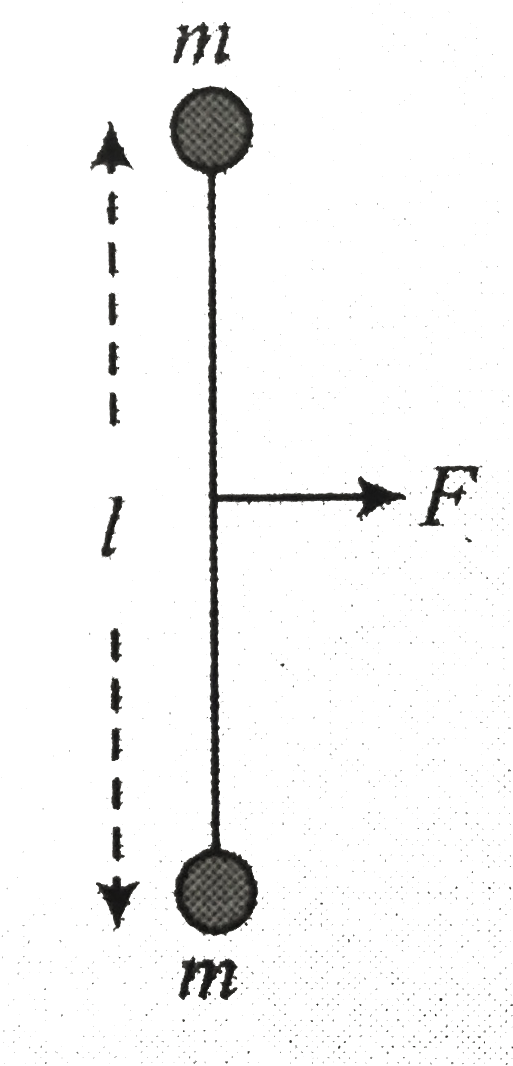The motion of a particle of mass m is described by y=ut+12gt2 . Find the force acting on the particale .
1.mg
2.μt
3.2mg
4.2μt
The correct Answer is:A
To solve the problem, we need to find the force acting on a particle of mass m whose motion is described by the equation:
y=ut+12gt2
1. Identify the Equation of Motion:
The given equation y=ut+12gt2 describes the vertical motion of a particle under the influence of gravity, where:
- y is the vertical displacement,
- u is the initial velocity,
- g is the acceleration due to gravity,
- t is the time.
2. Differentiate to Find Velocity:
To find the velocity v, we differentiate the displacement y with respect to time t:
v=dydt=ddt(ut+12gt2)
Using the power rule of differentiation:
v=u+gt
3. Differentiate to Find Acceleration:
Now, we differentiate the velocity v with respect to time t to find the acceleration a:
a=dvdt=ddt(u+gt)
Since u is a constant, its derivative is 0:
a=0+g=g
4. Apply Newton's Second Law:
According to Newton's second law, the force F acting on an object is given by:
F=ma
Substituting the value of acceleration a:
F=mg
5. Conclusion:
The force acting on the particle is:
F=mg
Final Answer:
The force acting on the particle is F=mg.
---
The given equation y=ut+12gt2 describes the vertical motion of a particle under the influence of gravity, where:
- y is the vertical displacement,
- u is the initial velocity,
- g is the acceleration due to gravity,
- t is the time.
To find the velocity v, we differentiate the displacement y with respect to time t:
v=dydt=ddt(ut+12gt2)
Using the power rule of differentiation:
v=u+gt
Now, we differentiate the velocity v with respect to time t to find the acceleration a:
a=dvdt=ddt(u+gt)
Since u is a constant, its derivative is 0:
a=0+g=g
According to Newton's second law, the force F acting on an object is given by:
F=ma
Substituting the value of acceleration a:
F=mg
The force acting on the particle is:
F=mg
The force acting on the particle is F=mg.
Topper's Solved these Questions
- LAWS OF MOTIONBOOK - NCERT FINGERTPS ENGLISHCHAPTER - LAWS OF MOTIONEXERCISE - HOTS
8 Videos
- LAWS OF MOTIONBOOK - NCERT FINGERTPS ENGLISHCHAPTER - LAWS OF MOTIONEXERCISE - Exemplar Problems
9 Videos
- KINETIC THEORYBOOK - NCERT FINGERTPS ENGLISHCHAPTER - KINETIC THEORYEXERCISE - Assertion And Reason
10 Videos
- MECHANICAL PROPERTIES OF FLUIDSBOOK - NCERT FINGERTPS ENGLISHCHAPTER - MECHANICAL PROPERTIES OF FLUIDSEXERCISE - NCERT Exemplar
5 Videos
Similar Questions
Two identical small masses each of mass m are connected by a light inextensible string on a smooth horizontal floor. A constant force F is applied at the mid point of the string as shown in fig. find the acceleration of each mass towards each other.

View SolutionA ball is travelling with uniform translatory motion . This means that
View SolutionAssertion: All molecules of an ideal gas more with the same speed.
Reason: There is no attraction between the molecules in an ideal gas.
View SolutionA tall cylinder is filled with viscous oil. A round pebble is dropped from the top with zero initial velocity. From the plot shown in figure, indicate the one that represents the velocity (v) of the pebble as a function of time (t)
View SolutionThe motion of a particle of mass m is described by y =ut + (1)/(2) g t^(2) . Find the force acting on the particale .
View Solutionm द्रव्यमान के एक कण की गति का समीकरण है-
x=ut+12gt2
कण पर कार्यरत बल का मान ज्ञात कीजिए।
View SolutionThe motion of a particle of mass m is described by h= ut+1//2 gt^2. Find the force acting on particle. (F=mg).
View SolutionThe motion of a particle of mass m is described by h= ut + 1//2 "gt"^2 . Find the force acting on particle.
View Solutionद्रव्यमान m के एक कण की गति, y=ut+12gt2 से वर्णित है। उस कण पर लगने वाले बल को ज्ञात करो।
View SolutionThe motion of a particle of mass m is described by y=ut+12gt2 . Find the force acting on the particle.
View SolutionThe motion of a particle of mass m is described by y = ut + 1/2 "gt"^2 . Find the force acting on the particle.
View SolutionThe motion of a particle of mass m is described by y=ut+12gt2 . Find the force acting on the particle.
View SolutionThe motion of a particle of mass m is described by y=ut+12gt2 . Find the force acting on the particle.
View SolutionThe motion of a particle of mass m is described by y =ut + (1)/(2) g t^(2) . Find the force acting on the particale .
View Solution(x, t), (y, t) diagram of a particle moving in 2-dimensions If the particle has a mass of 500 g, find the force (direction and magnitude) acting on the particle.
View Solution

